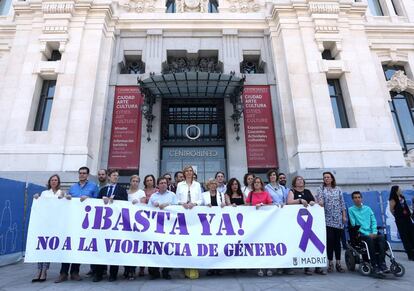Do heat waves fuel domestic violence?
A study has found that soaring temperatures can increase the risk of gender-based homicide by 40%

While admitting that the roots of violence against women “have clear ties to gender inequality and the patriarchal system,” additional factors such as soaring temperatures appear to play a role, according to a team of Spanish researchers. And “the risk of intimate partner femicides increases three days after a heat wave.”
The conclusions of a study conducted by experts in gender-based violence, epidemiology and psychologists at the National Police and Civil Guard have been drawn from research carried out between the months of May and September in the 2008-2016 period in the Madrid region.
Reports of gender-based violence rise on Sundays and over the Christmas break
Over this period, 23 women were killed by their current or former partners; 38,000 police complaints were filed for gender violence, and 61,000 calls were made to the 016 helpline for victims of domestic abuse. Published in Science of the Total Environment, the study, called “Heat wave and the risk of intimate partner violence,” shows that for every degree that a given day’s highest temperature goes over the 34ºC threshold, intimate partner femicides rise by 28.8%.
According to sociologist Carmen Vives, co-author of the report and president of the Spanish Epidemiology Society, “we have established a link between high temperatures and the killing of women that is sufficiently significant to be taken into account when devising alerts and protection protocols for heat waves.”
Heat exacerbates stress and irritability in relationships that are already charged with conflict, explains Vives while insisting that sexism and patriarchy are ultimately to blame.
The research is part of a growing scientific movement that aims to identify the factors that increase the risk of domestic violence. In a study carried out in 2016 on the social demographics of domestic violence in Spain, Vives’ team highlighted the fact that the risk of gender-based violence is strongly linked to immigrant status, belonging to an ethnic minority, having a partner or former partner who is unemployed, and the consumption of alcohol and drugs by either one or both parties.
What kills is not heat but sexism Epidemiologist Belén Sanz
The research found that 40% of women murdered in Spain by their partners or former partners were immigrants, predominantly from Ecuador, Morocco and Bolivia. “Being an immigrant and not having family support or a social network makes it hard when you find yourself in a violent situation and want to escape from it,” says Vives.
Immigrant women who are exposed to violence within their relationship are five times more likely to be killed than a Spanish woman, according to Vives. The research has also shown that women subjected to gender violence in rural settings are three times more likely to be killed than those living in an urban environment.
The new study suggests that once temperatures rise above 34ºC, the consequences can be fatally accumulative. One day after the threshold has been crossed, police reports rise in proportion to ever extra degree by 1.7%. Three days later, the risk of fatal assault has increased by 40%p. And five days later, the victim’s helpline receives 1.43% more calls for every extra degree.
“What kills is not the heat, it’s the sexism,” says epidemiologist Belén Sanz from the Carlos III Health Institute in Madrid. “We have to focus on the murderer, but clearly the violence rises with the temperature.”
Female immigrants and women living in rural environments are at greater risk of being killed than those who live in towns and cities
The first studies linking heat to gender-based violence were published in the United States in 1986. “It’s feasible that being exposed to abnormally high temperatures would be a catalyst leading to this type of dynamic within the couple – stress, anger, arguments – reaching the boiling point, murder, three days after it began, as the findings show,” says the study, whose authors include Civil Guard Lieutenant Colonel José Luis González and National Police psychologist Juan José López Ossorio, both of whom are coordinating a team that analyzes homicides within the context of gender violence in Spain, and which answers to the Interior Ministry.
The team’s findings will provide the basis for preventive campaigns aimed at geographical areas and demographic groups that have been shown to be high risk. “As in the rest of the world, homicides in Spain carried out by a partner or a former partner are the main cause of violent death for women,” say González and López Ossorio in the 2018 Annual Criminal Psychology report. “Although the prevalence in Spain is low, it has a big social impact. Paradoxically, there are few systemic studies carried out in our country allowing us to become better acquainted with the nature of this kind of crime – the patterns, the tendencies and the key elements which would allow the development of strategies to reduce and even eradicate the phenomenon.”
González and López Ossorio have just published another study on the classification of domestic homicides. The study points out that Spain has, in fact, one of the lowest rates of femicides in the world, with 2.4 murders for every million women compared to 3.2 in Switzerland, 4.1 in Germany, 5.4 in Finland, and 9.4 in Lithuania.
The researchers cite recent work carried out in Australia by the criminologist Holly Johnson, who concludes that in general the perpetrators of domestic violence have a low level of education and are often involved in drugs or alcohol abuse. Other factors include having suffered physical or sexual abuse as children, to financial hardship, undiagnosed mental health issues, an undesired split with their partner, witnessing abuse against their mother as children, and a record of harassment and violent crime.
In Norway, the psychologist Solveig Vatnar looked at 177 homicides committed within relationships and also observed a link with a low socioeconomic status. Meanwhile, in Spain, the Interior Ministry team will release its first conclusions in the fall.
Besides potential environmental aggravations such as the temperature, other factors such as time are also being studied. For example, it has been noted that the victim helpline tends to be busier on Mondays, when many women find themselves temporarily free from their aggressor. Complaints to the police, on the other hand, are at their most intense on Sundays and during the Christmas break, according to a report in the Annals of Epidemiology. Being aware of these risk factors facilitates a more efficient response to victims.
“I am in no doubt that there are variables that increase or decrease the probability of suffering gender violence or becoming a perpetrator of it,” says Bélen Sanz. “Women who are immigrants or who are in a lower socioeconomic bracket are at higher risk. So long as this is not recognized, there will be no specific preventive programs for them.”
English version by Heather Galloway.
Tu suscripción se está usando en otro dispositivo
¿Quieres añadir otro usuario a tu suscripción?
Si continúas leyendo en este dispositivo, no se podrá leer en el otro.
FlechaTu suscripción se está usando en otro dispositivo y solo puedes acceder a EL PAÍS desde un dispositivo a la vez.
Si quieres compartir tu cuenta, cambia tu suscripción a la modalidad Premium, así podrás añadir otro usuario. Cada uno accederá con su propia cuenta de email, lo que os permitirá personalizar vuestra experiencia en EL PAÍS.
¿Tienes una suscripción de empresa? Accede aquí para contratar más cuentas.
En el caso de no saber quién está usando tu cuenta, te recomendamos cambiar tu contraseña aquí.
Si decides continuar compartiendo tu cuenta, este mensaje se mostrará en tu dispositivo y en el de la otra persona que está usando tu cuenta de forma indefinida, afectando a tu experiencia de lectura. Puedes consultar aquí los términos y condiciones de la suscripción digital.
More information
Archived In
Últimas noticias
The complicated life of Francesca Albanese: A rising figure in Italy but barred from every bank by Trump’s sanctions
How Japan is trying to avert ‘digital defeat’
Half of Scotland is in the hands of 420 property owners
Reinhard Genzel, Nobel laureate in physics: ‘One-minute videos will never give you the truth’
Most viewed
- Pablo Escobar’s hippos: A serious environmental problem, 40 years on
- Why we lost the habit of sleeping in two segments and how that changed our sense of time
- Charles Dubouloz, mountaineering star, retires at 36 with a farewell tour inspired by Walter Bonatti
- Reinhard Genzel, Nobel laureate in physics: ‘One-minute videos will never give you the truth’
- The Florida Keys tourist paradise is besieged by immigration agents: ‘We’ve never seen anything like this’











































